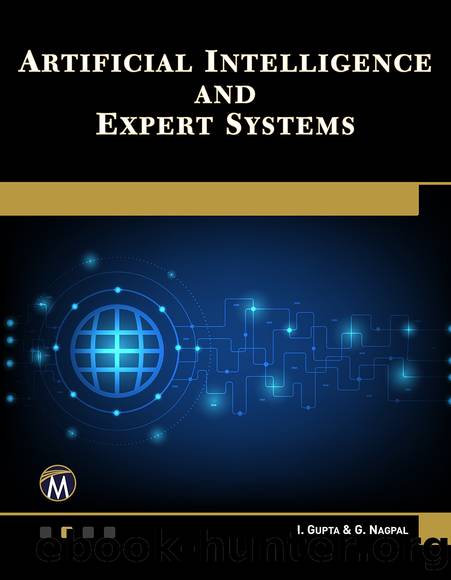Artificial Intelligence and Expert Systems by Itisha Gupta and Garima Nagpal

Author:Itisha Gupta and Garima Nagpal
Language: eng
Format: epub
ISBN: 9781683925071
Publisher: Copyright © 2019 by Mercury Learning and Information LLC.
Published: 2019-10-15T00:00:00+00:00
FIGURE 8.26
â¢Solution for Problem 2: score(Spurs, Norwich, 3-1)
FIGURE 8.27
â¢Solution for Problem 3: John gave Mary the book.
FIGURE 8.28
8.7.2.4Partitioned Semantic Network
One of the limitations of the semantic network is that it cannot be used to represent quantified statements (for all â and there exist â) like
âEvery dog has bitten a postman.â
âEvery dog has bitten every postman.â
The solution to this problem is to use a partitioned semantic network. Hendrix (1976: 21-49, 1979: 51-91) developed the so-called partitioned semantic network to represent the difference between the description of an individual object or process and the description of a set of objects. The set description involves quantification.
Hendrix partitioned a semantic network; a semantic network, loosely speaking, can be divided into one or more networks for the description of an individual.
Partitioned semantic networks have the expressive power of predicate calculus that we discussed previously. That is negation, conjunction, disjunction, and implication all can be represented using a partitioned semantic network which otherwise is not possible with a semantic network. But we cannot neglect the advantages of a semantic network, like two-way indexing, direct set-subset element representation, and variable classifications according to types.
Partitioned Semantic Networks Allow For
â¢propositions to be made without commitment to truth
â¢expressions to be quantified
In it, the network is broken into spaces, which consist of groups of nodes and arcs and regard each space as a node. Therefore, the central idea of partitioning is to allow groups, nodes, and arcs to be bundled together into units called spaces â fundamental entities in partitioned networks, on the same level as nodes and arcs (Hendrix 1979:59).
â¢Every node and every arc of a network belongs to (or lies in/on) one or more spaces.
â¢Some spaces are used to encode âbackground informationâ or generic relations; others are used to deal with specifics called âscratchâ space.
In a partitioned semantic network, the partition is used as a barrier. Since the network is a sub-graph, a partitioned semantic network creates a subgraph that has two important advantages:
â¢Syntactic: It is useful to delimit that part of the network that represents the results of specific inferences.
â¢Semantic: It is useful to delimit that part of the network that represents knowledge about specific objects. Partitioning may then be used to impose a hierarchy upon a flat structure of nodes.
Consider the following:
âAndrew believes that the earth is flat.â We can encode the proposition âthe earth is flatâ in a space and within it have nodes and arcs to represent the fact (see Figure 8.29). We can have nodes and arcs to link this space the rest of the network to represent Andrewâs belief.
Download
This site does not store any files on its server. We only index and link to content provided by other sites. Please contact the content providers to delete copyright contents if any and email us, we'll remove relevant links or contents immediately.
| AI & Machine Learning | Bioinformatics |
| Computer Simulation | Cybernetics |
| Human-Computer Interaction | Information Theory |
| Robotics | Systems Analysis & Design |
Algorithms of the Intelligent Web by Haralambos Marmanis;Dmitry Babenko(8517)
Test-Driven Development with Java by Alan Mellor(7328)
Data Augmentation with Python by Duc Haba(7232)
Principles of Data Fabric by Sonia Mezzetta(6977)
Learn Blender Simulations the Right Way by Stephen Pearson(6907)
Microservices with Spring Boot 3 and Spring Cloud by Magnus Larsson(6743)
RPA Solution Architect's Handbook by Sachin Sahgal(6146)
Hadoop in Practice by Alex Holmes(6026)
Jquery UI in Action : Master the concepts Of Jquery UI: A Step By Step Approach by ANMOL GOYAL(5865)
The Infinite Retina by Robert Scoble Irena Cronin(5845)
Big Data Analysis with Python by Ivan Marin(5685)
Life 3.0: Being Human in the Age of Artificial Intelligence by Tegmark Max(5394)
Pretrain Vision and Large Language Models in Python by Emily Webber(4644)
Infrastructure as Code for Beginners by Russ McKendrick(4425)
WordPress Plugin Development Cookbook by Yannick Lefebvre(4155)
Functional Programming in JavaScript by Mantyla Dan(4116)
The Age of Surveillance Capitalism by Shoshana Zuboff(4107)
Embracing Microservices Design by Ovais Mehboob Ahmed Khan Nabil Siddiqui and Timothy Oleson(3945)
Applied Machine Learning for Healthcare and Life Sciences Using AWS by Ujjwal Ratan(3918)
